Economics Report: Analysis of the International Monetary Fund
VerifiedAdded on 2023/04/11
|21
|3828
|349
Report
AI Summary
This economics report provides an in-depth analysis of the International Monetary Fund (IMF). It begins with a brief background and the origins of the IMF, highlighting the roles of economists like John Keynes and Harry Dexter in its formation. The report then delves into the IMF's objectives, including promoting international trade, ensuring stable exchange rates, and fostering economic growth. It explores the historical and current roles of the IMF, such as managing financial crises and providing financial assistance to countries facing balance of payments difficulties, referencing examples like Greece, Portugal, and Ireland. The report also assesses the IMF's successes and failures, particularly in the context of global trade and economic stability. Finally, it concludes by summarizing the IMF's overall role and its relevance in the modern global economy, emphasizing its importance in international finance and its influence on developing countries.
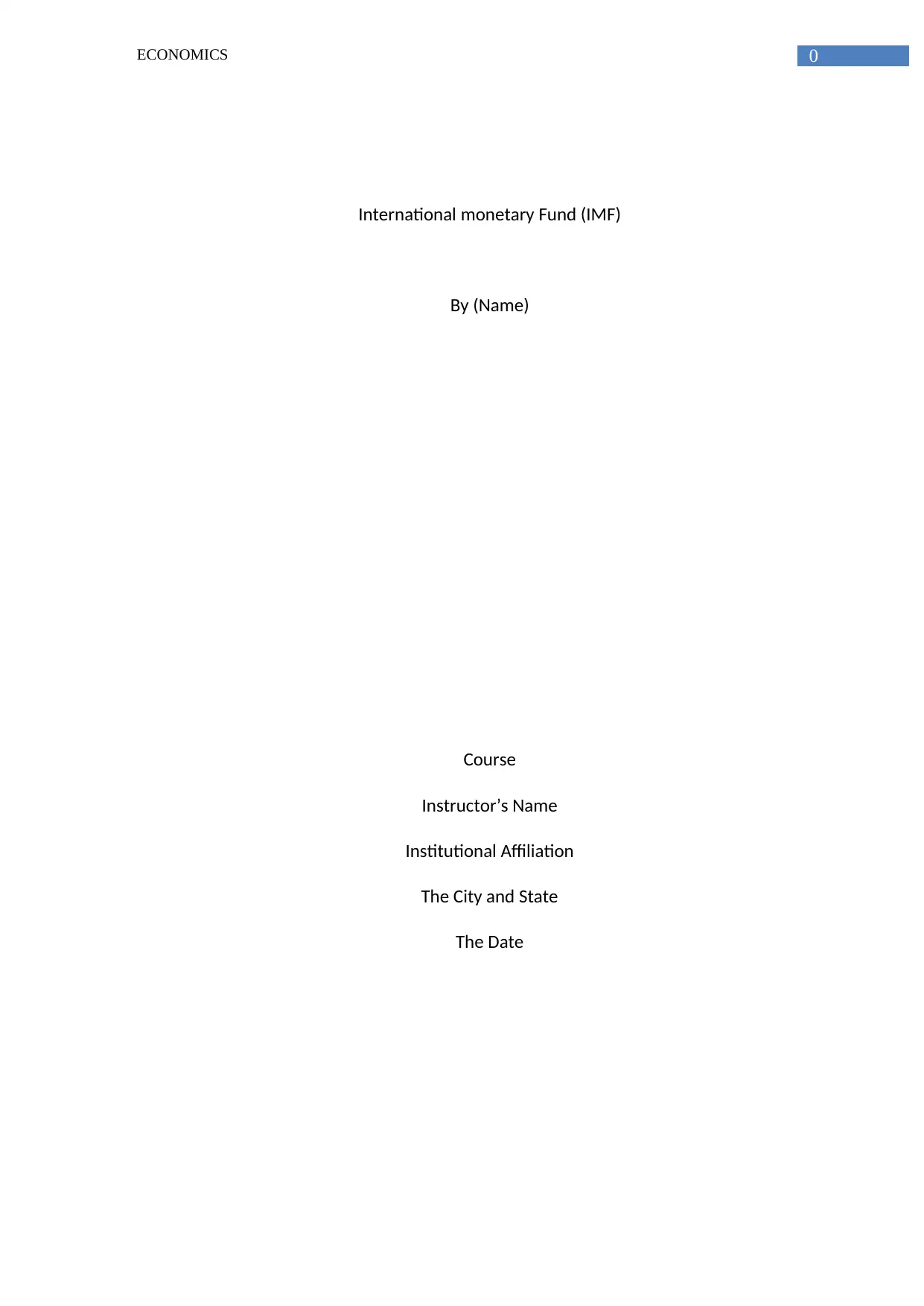
0ECONOMICS
International monetary Fund (IMF)
By (Name)
Course
Instructor’s Name
Institutional Affiliation
The City and State
The Date
International monetary Fund (IMF)
By (Name)
Course
Instructor’s Name
Institutional Affiliation
The City and State
The Date
Paraphrase This Document
Need a fresh take? Get an instant paraphrase of this document with our AI Paraphraser
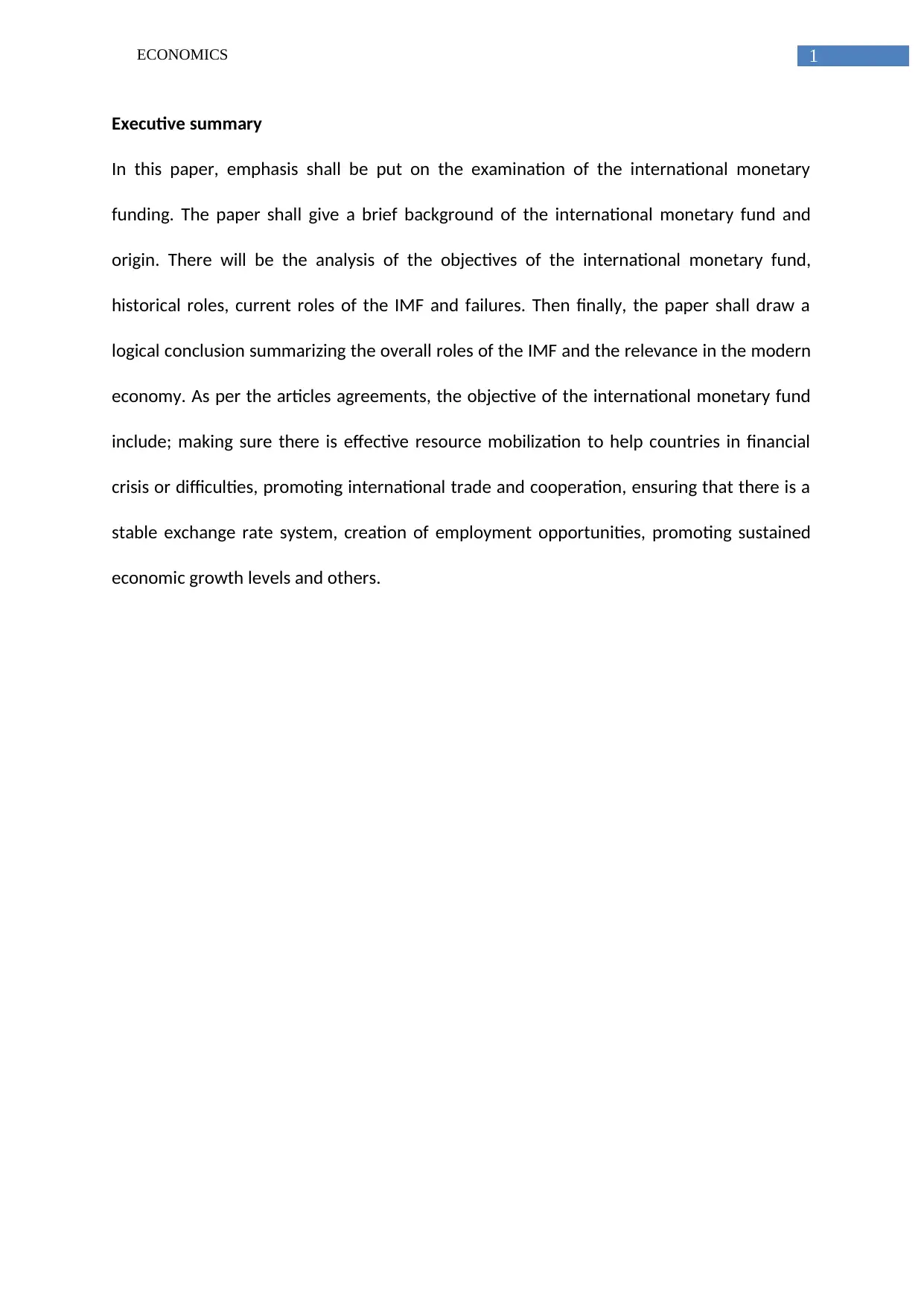
1ECONOMICS
Executive summary
In this paper, emphasis shall be put on the examination of the international monetary
funding. The paper shall give a brief background of the international monetary fund and
origin. There will be the analysis of the objectives of the international monetary fund,
historical roles, current roles of the IMF and failures. Then finally, the paper shall draw a
logical conclusion summarizing the overall roles of the IMF and the relevance in the modern
economy. As per the articles agreements, the objective of the international monetary fund
include; making sure there is effective resource mobilization to help countries in financial
crisis or difficulties, promoting international trade and cooperation, ensuring that there is a
stable exchange rate system, creation of employment opportunities, promoting sustained
economic growth levels and others.
Executive summary
In this paper, emphasis shall be put on the examination of the international monetary
funding. The paper shall give a brief background of the international monetary fund and
origin. There will be the analysis of the objectives of the international monetary fund,
historical roles, current roles of the IMF and failures. Then finally, the paper shall draw a
logical conclusion summarizing the overall roles of the IMF and the relevance in the modern
economy. As per the articles agreements, the objective of the international monetary fund
include; making sure there is effective resource mobilization to help countries in financial
crisis or difficulties, promoting international trade and cooperation, ensuring that there is a
stable exchange rate system, creation of employment opportunities, promoting sustained
economic growth levels and others.
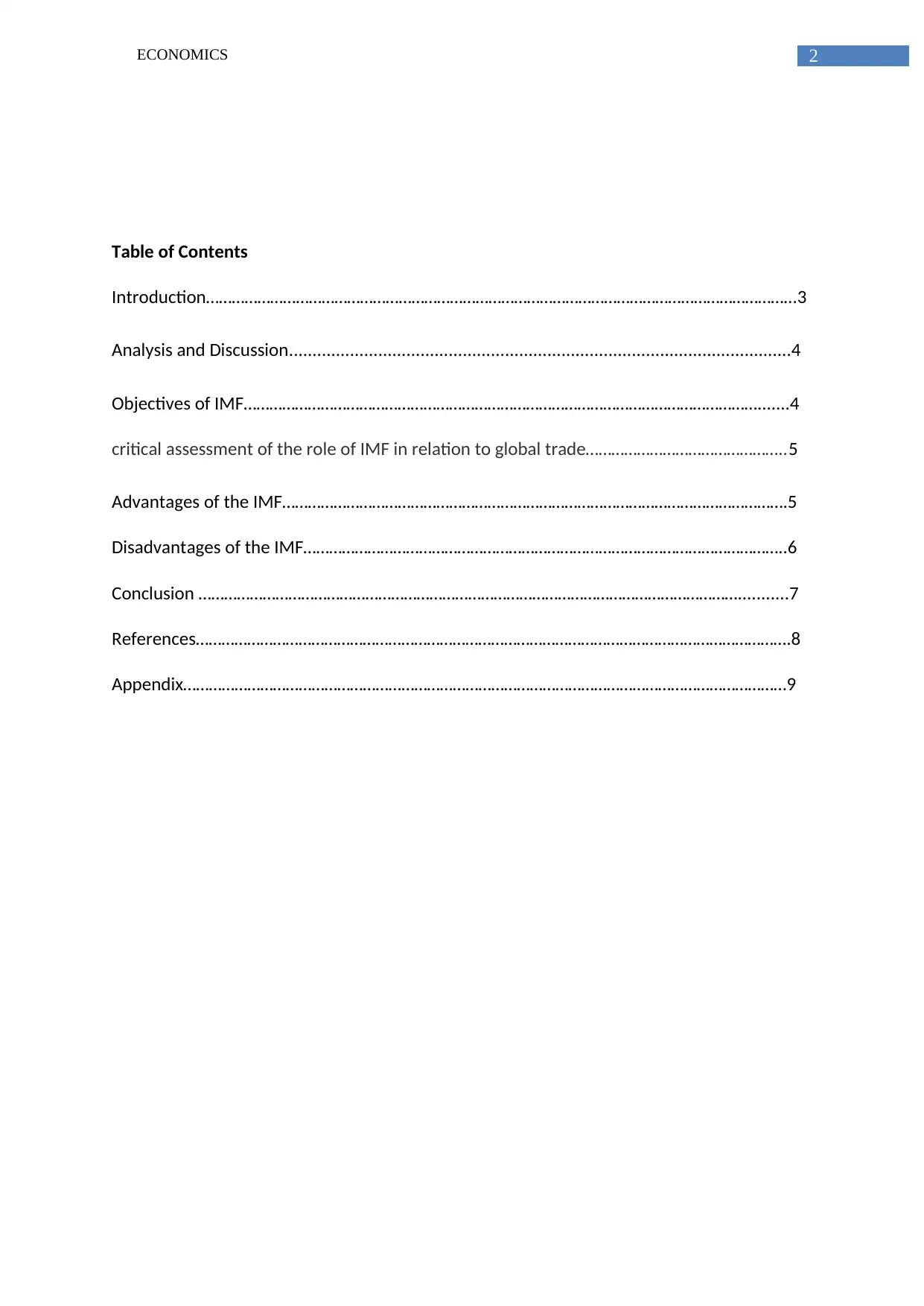
2ECONOMICS
Table of Contents
Introduction…………………………………………………………………………………………………………………………3
Analysis and Discussion...........................................................................................................4
Objectives of IMF………………………………………………………………………………………………………….......4
critical assessment of the role of IMF in relation to global trade………………………………………..5
Advantages of the IMF……………………………………………………………………………………………………….5
Disadvantages of the IMF…………………………………………………………………………………………………..6
Conclusion ………………………………………………………………………………………………………………...........7
References………………………………………………………………………………………………………………………….8
Appendix……………………………………………………………………………………………………………………………9
Table of Contents
Introduction…………………………………………………………………………………………………………………………3
Analysis and Discussion...........................................................................................................4
Objectives of IMF………………………………………………………………………………………………………….......4
critical assessment of the role of IMF in relation to global trade………………………………………..5
Advantages of the IMF……………………………………………………………………………………………………….5
Disadvantages of the IMF…………………………………………………………………………………………………..6
Conclusion ………………………………………………………………………………………………………………...........7
References………………………………………………………………………………………………………………………….8
Appendix……………………………………………………………………………………………………………………………9
⊘ This is a preview!⊘
Do you want full access?
Subscribe today to unlock all pages.

Trusted by 1+ million students worldwide
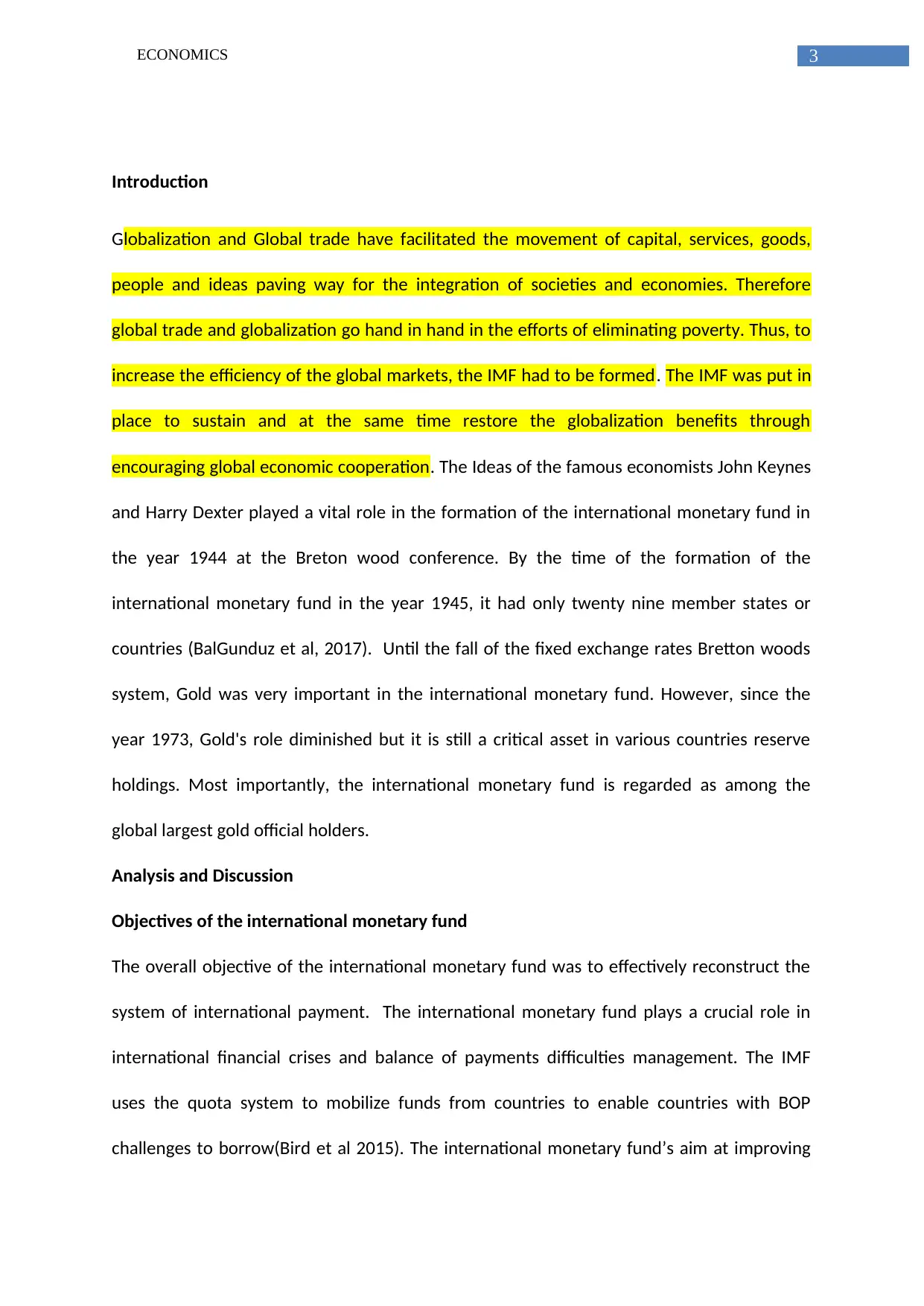
3ECONOMICS
Introduction
Globalization and Global trade have facilitated the movement of capital, services, goods,
people and ideas paving way for the integration of societies and economies. Therefore
global trade and globalization go hand in hand in the efforts of eliminating poverty. Thus, to
increase the efficiency of the global markets, the IMF had to be formed. The IMF was put in
place to sustain and at the same time restore the globalization benefits through
encouraging global economic cooperation. The Ideas of the famous economists John Keynes
and Harry Dexter played a vital role in the formation of the international monetary fund in
the year 1944 at the Breton wood conference. By the time of the formation of the
international monetary fund in the year 1945, it had only twenty nine member states or
countries (BalGunduz et al, 2017). Until the fall of the fixed exchange rates Bretton woods
system, Gold was very important in the international monetary fund. However, since the
year 1973, Gold's role diminished but it is still a critical asset in various countries reserve
holdings. Most importantly, the international monetary fund is regarded as among the
global largest gold official holders.
Analysis and Discussion
Objectives of the international monetary fund
The overall objective of the international monetary fund was to effectively reconstruct the
system of international payment. The international monetary fund plays a crucial role in
international financial crises and balance of payments difficulties management. The IMF
uses the quota system to mobilize funds from countries to enable countries with BOP
challenges to borrow(Bird et al 2015). The international monetary fund’s aim at improving
Introduction
Globalization and Global trade have facilitated the movement of capital, services, goods,
people and ideas paving way for the integration of societies and economies. Therefore
global trade and globalization go hand in hand in the efforts of eliminating poverty. Thus, to
increase the efficiency of the global markets, the IMF had to be formed. The IMF was put in
place to sustain and at the same time restore the globalization benefits through
encouraging global economic cooperation. The Ideas of the famous economists John Keynes
and Harry Dexter played a vital role in the formation of the international monetary fund in
the year 1944 at the Breton wood conference. By the time of the formation of the
international monetary fund in the year 1945, it had only twenty nine member states or
countries (BalGunduz et al, 2017). Until the fall of the fixed exchange rates Bretton woods
system, Gold was very important in the international monetary fund. However, since the
year 1973, Gold's role diminished but it is still a critical asset in various countries reserve
holdings. Most importantly, the international monetary fund is regarded as among the
global largest gold official holders.
Analysis and Discussion
Objectives of the international monetary fund
The overall objective of the international monetary fund was to effectively reconstruct the
system of international payment. The international monetary fund plays a crucial role in
international financial crises and balance of payments difficulties management. The IMF
uses the quota system to mobilize funds from countries to enable countries with BOP
challenges to borrow(Bird et al 2015). The international monetary fund’s aim at improving
Paraphrase This Document
Need a fresh take? Get an instant paraphrase of this document with our AI Paraphraser
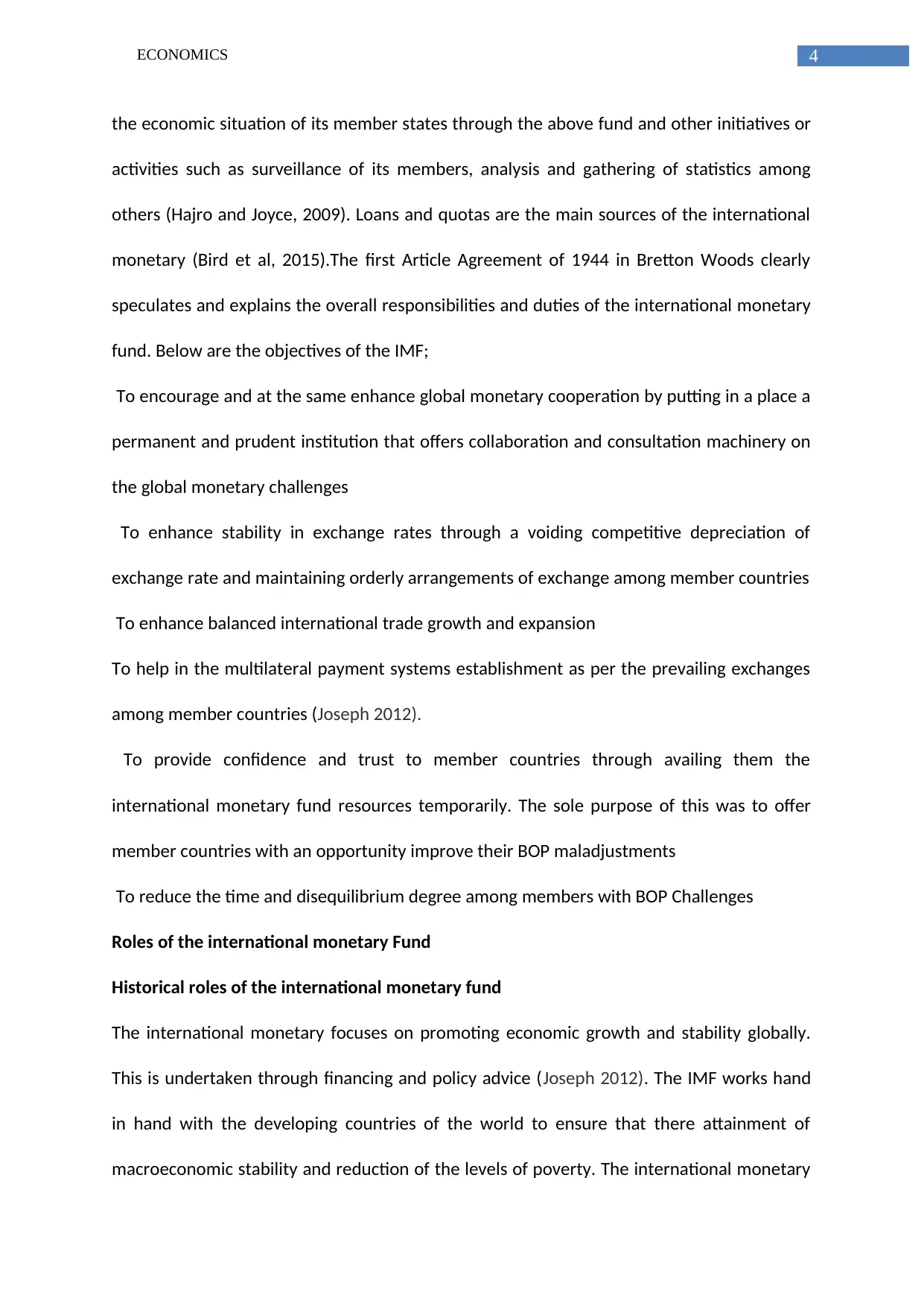
4ECONOMICS
the economic situation of its member states through the above fund and other initiatives or
activities such as surveillance of its members, analysis and gathering of statistics among
others (Hajro and Joyce, 2009). Loans and quotas are the main sources of the international
monetary (Bird et al, 2015).The first Article Agreement of 1944 in Bretton Woods clearly
speculates and explains the overall responsibilities and duties of the international monetary
fund. Below are the objectives of the IMF;
To encourage and at the same enhance global monetary cooperation by putting in a place a
permanent and prudent institution that offers collaboration and consultation machinery on
the global monetary challenges
To enhance stability in exchange rates through a voiding competitive depreciation of
exchange rate and maintaining orderly arrangements of exchange among member countries
To enhance balanced international trade growth and expansion
To help in the multilateral payment systems establishment as per the prevailing exchanges
among member countries (Joseph 2012).
To provide confidence and trust to member countries through availing them the
international monetary fund resources temporarily. The sole purpose of this was to offer
member countries with an opportunity improve their BOP maladjustments
To reduce the time and disequilibrium degree among members with BOP Challenges
Roles of the international monetary Fund
Historical roles of the international monetary fund
The international monetary focuses on promoting economic growth and stability globally.
This is undertaken through financing and policy advice (Joseph 2012). The IMF works hand
in hand with the developing countries of the world to ensure that there attainment of
macroeconomic stability and reduction of the levels of poverty. The international monetary
the economic situation of its member states through the above fund and other initiatives or
activities such as surveillance of its members, analysis and gathering of statistics among
others (Hajro and Joyce, 2009). Loans and quotas are the main sources of the international
monetary (Bird et al, 2015).The first Article Agreement of 1944 in Bretton Woods clearly
speculates and explains the overall responsibilities and duties of the international monetary
fund. Below are the objectives of the IMF;
To encourage and at the same enhance global monetary cooperation by putting in a place a
permanent and prudent institution that offers collaboration and consultation machinery on
the global monetary challenges
To enhance stability in exchange rates through a voiding competitive depreciation of
exchange rate and maintaining orderly arrangements of exchange among member countries
To enhance balanced international trade growth and expansion
To help in the multilateral payment systems establishment as per the prevailing exchanges
among member countries (Joseph 2012).
To provide confidence and trust to member countries through availing them the
international monetary fund resources temporarily. The sole purpose of this was to offer
member countries with an opportunity improve their BOP maladjustments
To reduce the time and disequilibrium degree among members with BOP Challenges
Roles of the international monetary Fund
Historical roles of the international monetary fund
The international monetary focuses on promoting economic growth and stability globally.
This is undertaken through financing and policy advice (Joseph 2012). The IMF works hand
in hand with the developing countries of the world to ensure that there attainment of
macroeconomic stability and reduction of the levels of poverty. The international monetary
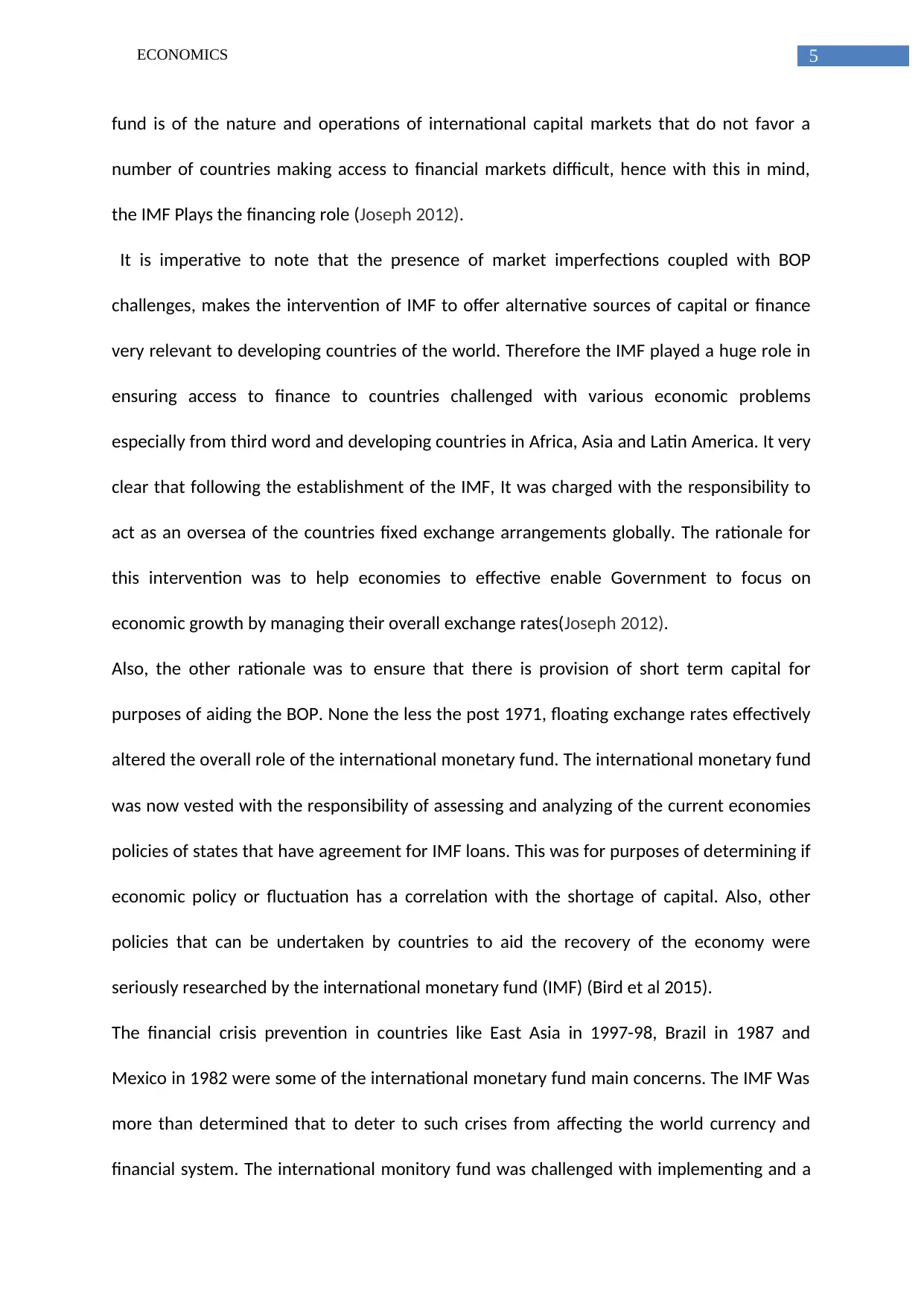
5ECONOMICS
fund is of the nature and operations of international capital markets that do not favor a
number of countries making access to financial markets difficult, hence with this in mind,
the IMF Plays the financing role (Joseph 2012).
It is imperative to note that the presence of market imperfections coupled with BOP
challenges, makes the intervention of IMF to offer alternative sources of capital or finance
very relevant to developing countries of the world. Therefore the IMF played a huge role in
ensuring access to finance to countries challenged with various economic problems
especially from third word and developing countries in Africa, Asia and Latin America. It very
clear that following the establishment of the IMF, It was charged with the responsibility to
act as an oversea of the countries fixed exchange arrangements globally. The rationale for
this intervention was to help economies to effective enable Government to focus on
economic growth by managing their overall exchange rates(Joseph 2012).
Also, the other rationale was to ensure that there is provision of short term capital for
purposes of aiding the BOP. None the less the post 1971, floating exchange rates effectively
altered the overall role of the international monetary fund. The international monetary fund
was now vested with the responsibility of assessing and analyzing of the current economies
policies of states that have agreement for IMF loans. This was for purposes of determining if
economic policy or fluctuation has a correlation with the shortage of capital. Also, other
policies that can be undertaken by countries to aid the recovery of the economy were
seriously researched by the international monetary fund (IMF) (Bird et al 2015).
The financial crisis prevention in countries like East Asia in 1997-98, Brazil in 1987 and
Mexico in 1982 were some of the international monetary fund main concerns. The IMF Was
more than determined that to deter to such crises from affecting the world currency and
financial system. The international monitory fund was challenged with implementing and a
fund is of the nature and operations of international capital markets that do not favor a
number of countries making access to financial markets difficult, hence with this in mind,
the IMF Plays the financing role (Joseph 2012).
It is imperative to note that the presence of market imperfections coupled with BOP
challenges, makes the intervention of IMF to offer alternative sources of capital or finance
very relevant to developing countries of the world. Therefore the IMF played a huge role in
ensuring access to finance to countries challenged with various economic problems
especially from third word and developing countries in Africa, Asia and Latin America. It very
clear that following the establishment of the IMF, It was charged with the responsibility to
act as an oversea of the countries fixed exchange arrangements globally. The rationale for
this intervention was to help economies to effective enable Government to focus on
economic growth by managing their overall exchange rates(Joseph 2012).
Also, the other rationale was to ensure that there is provision of short term capital for
purposes of aiding the BOP. None the less the post 1971, floating exchange rates effectively
altered the overall role of the international monetary fund. The international monetary fund
was now vested with the responsibility of assessing and analyzing of the current economies
policies of states that have agreement for IMF loans. This was for purposes of determining if
economic policy or fluctuation has a correlation with the shortage of capital. Also, other
policies that can be undertaken by countries to aid the recovery of the economy were
seriously researched by the international monetary fund (IMF) (Bird et al 2015).
The financial crisis prevention in countries like East Asia in 1997-98, Brazil in 1987 and
Mexico in 1982 were some of the international monetary fund main concerns. The IMF Was
more than determined that to deter to such crises from affecting the world currency and
financial system. The international monitory fund was challenged with implementing and a
⊘ This is a preview!⊘
Do you want full access?
Subscribe today to unlock all pages.

Trusted by 1+ million students worldwide
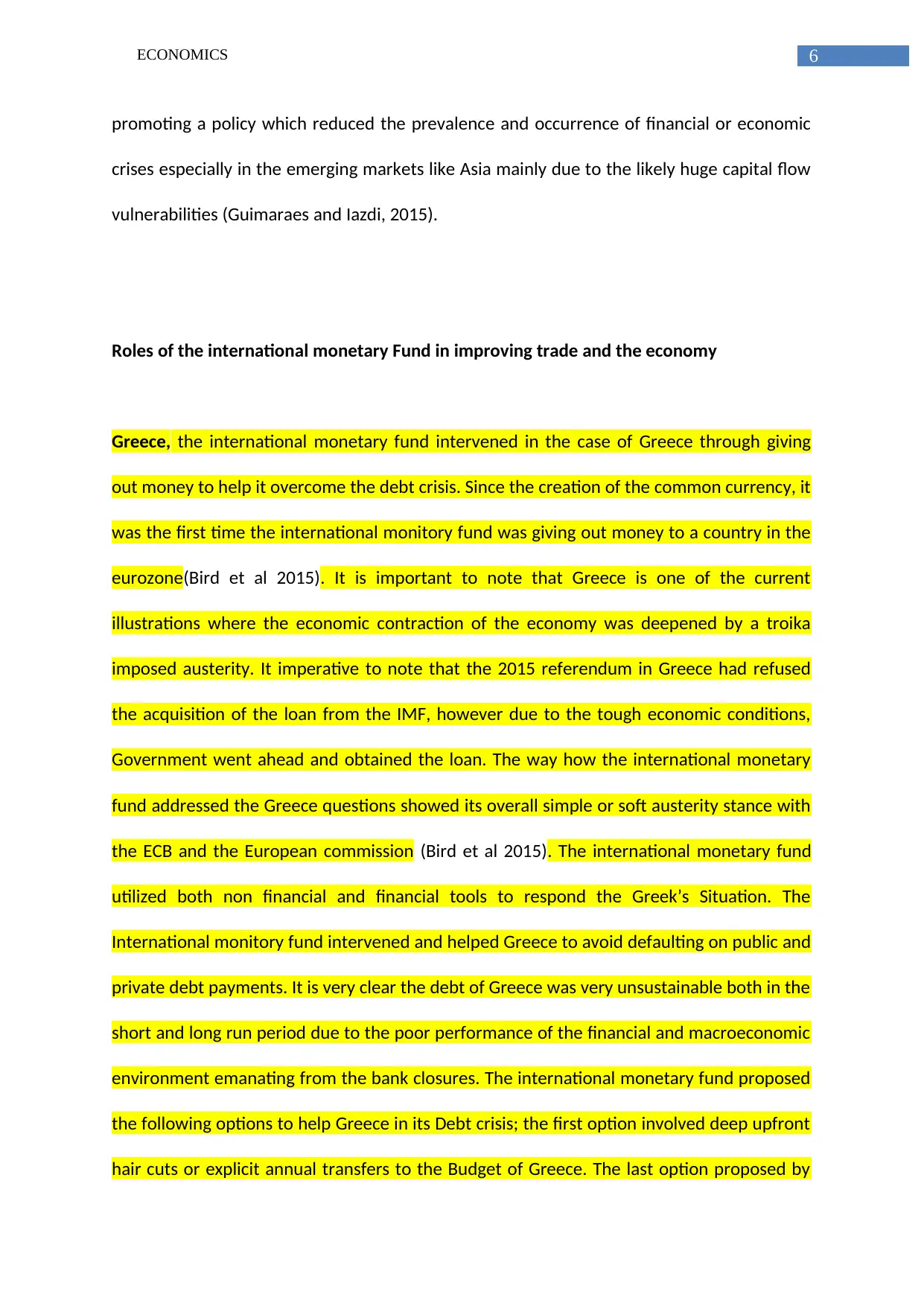
6ECONOMICS
promoting a policy which reduced the prevalence and occurrence of financial or economic
crises especially in the emerging markets like Asia mainly due to the likely huge capital flow
vulnerabilities (Guimaraes and Iazdi, 2015).
Roles of the international monetary Fund in improving trade and the economy
Greece, the international monetary fund intervened in the case of Greece through giving
out money to help it overcome the debt crisis. Since the creation of the common currency, it
was the first time the international monitory fund was giving out money to a country in the
eurozone(Bird et al 2015). It is important to note that Greece is one of the current
illustrations where the economic contraction of the economy was deepened by a troika
imposed austerity. It imperative to note that the 2015 referendum in Greece had refused
the acquisition of the loan from the IMF, however due to the tough economic conditions,
Government went ahead and obtained the loan. The way how the international monetary
fund addressed the Greece questions showed its overall simple or soft austerity stance with
the ECB and the European commission (Bird et al 2015). The international monetary fund
utilized both non financial and financial tools to respond the Greek’s Situation. The
International monitory fund intervened and helped Greece to avoid defaulting on public and
private debt payments. It is very clear the debt of Greece was very unsustainable both in the
short and long run period due to the poor performance of the financial and macroeconomic
environment emanating from the bank closures. The international monetary fund proposed
the following options to help Greece in its Debt crisis; the first option involved deep upfront
hair cuts or explicit annual transfers to the Budget of Greece. The last option proposed by
promoting a policy which reduced the prevalence and occurrence of financial or economic
crises especially in the emerging markets like Asia mainly due to the likely huge capital flow
vulnerabilities (Guimaraes and Iazdi, 2015).
Roles of the international monetary Fund in improving trade and the economy
Greece, the international monetary fund intervened in the case of Greece through giving
out money to help it overcome the debt crisis. Since the creation of the common currency, it
was the first time the international monitory fund was giving out money to a country in the
eurozone(Bird et al 2015). It is important to note that Greece is one of the current
illustrations where the economic contraction of the economy was deepened by a troika
imposed austerity. It imperative to note that the 2015 referendum in Greece had refused
the acquisition of the loan from the IMF, however due to the tough economic conditions,
Government went ahead and obtained the loan. The way how the international monetary
fund addressed the Greece questions showed its overall simple or soft austerity stance with
the ECB and the European commission (Bird et al 2015). The international monetary fund
utilized both non financial and financial tools to respond the Greek’s Situation. The
International monitory fund intervened and helped Greece to avoid defaulting on public and
private debt payments. It is very clear the debt of Greece was very unsustainable both in the
short and long run period due to the poor performance of the financial and macroeconomic
environment emanating from the bank closures. The international monetary fund proposed
the following options to help Greece in its Debt crisis; the first option involved deep upfront
hair cuts or explicit annual transfers to the Budget of Greece. The last option proposed by
Paraphrase This Document
Need a fresh take? Get an instant paraphrase of this document with our AI Paraphraser
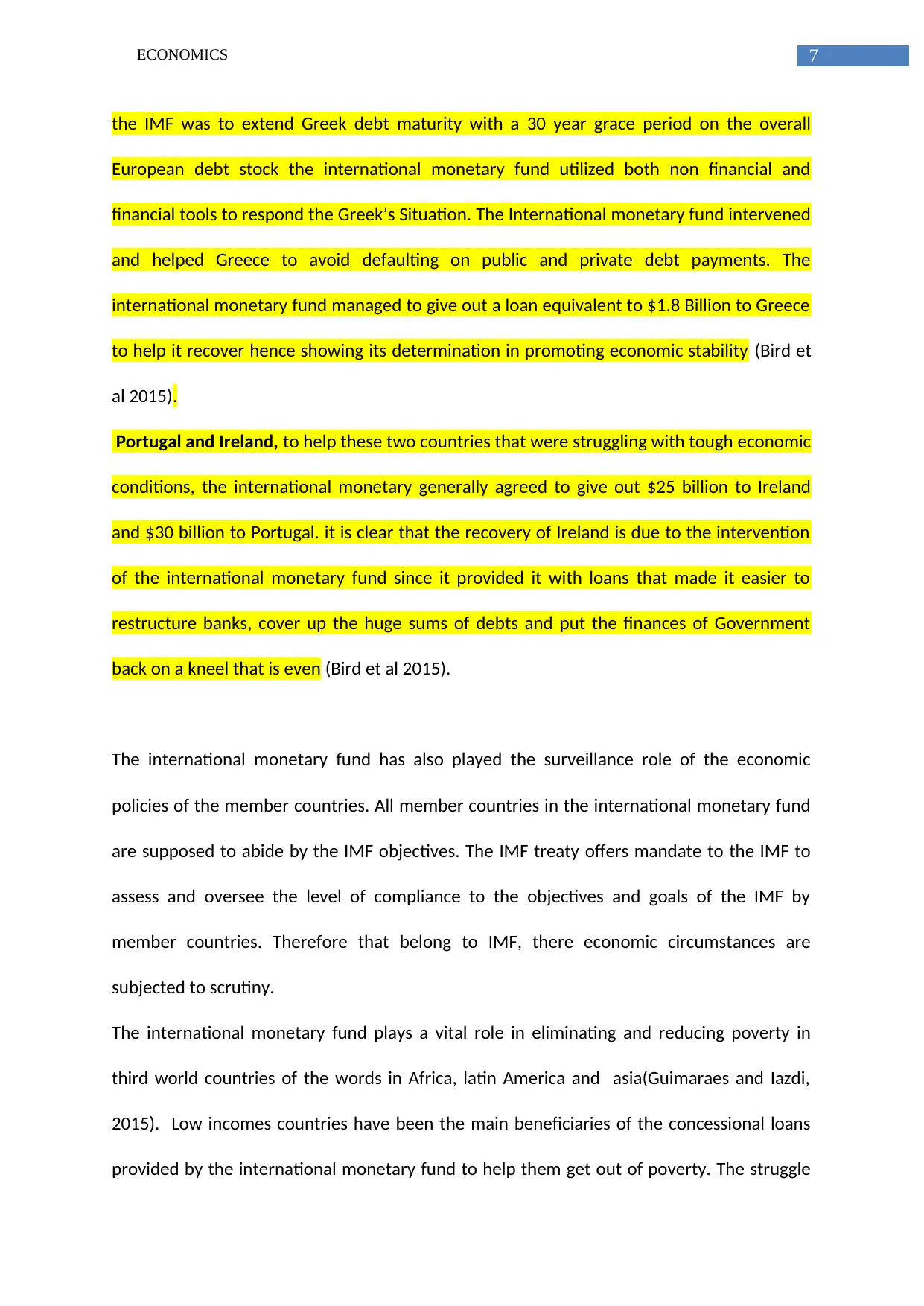
7ECONOMICS
the IMF was to extend Greek debt maturity with a 30 year grace period on the overall
European debt stock the international monetary fund utilized both non financial and
financial tools to respond the Greek’s Situation. The International monetary fund intervened
and helped Greece to avoid defaulting on public and private debt payments. The
international monetary fund managed to give out a loan equivalent to $1.8 Billion to Greece
to help it recover hence showing its determination in promoting economic stability (Bird et
al 2015).
Portugal and Ireland, to help these two countries that were struggling with tough economic
conditions, the international monetary generally agreed to give out $25 billion to Ireland
and $30 billion to Portugal. it is clear that the recovery of Ireland is due to the intervention
of the international monetary fund since it provided it with loans that made it easier to
restructure banks, cover up the huge sums of debts and put the finances of Government
back on a kneel that is even (Bird et al 2015).
The international monetary fund has also played the surveillance role of the economic
policies of the member countries. All member countries in the international monetary fund
are supposed to abide by the IMF objectives. The IMF treaty offers mandate to the IMF to
assess and oversee the level of compliance to the objectives and goals of the IMF by
member countries. Therefore that belong to IMF, there economic circumstances are
subjected to scrutiny.
The international monetary fund plays a vital role in eliminating and reducing poverty in
third world countries of the words in Africa, latin America and asia(Guimaraes and Iazdi,
2015). Low incomes countries have been the main beneficiaries of the concessional loans
provided by the international monetary fund to help them get out of poverty. The struggle
the IMF was to extend Greek debt maturity with a 30 year grace period on the overall
European debt stock the international monetary fund utilized both non financial and
financial tools to respond the Greek’s Situation. The International monetary fund intervened
and helped Greece to avoid defaulting on public and private debt payments. The
international monetary fund managed to give out a loan equivalent to $1.8 Billion to Greece
to help it recover hence showing its determination in promoting economic stability (Bird et
al 2015).
Portugal and Ireland, to help these two countries that were struggling with tough economic
conditions, the international monetary generally agreed to give out $25 billion to Ireland
and $30 billion to Portugal. it is clear that the recovery of Ireland is due to the intervention
of the international monetary fund since it provided it with loans that made it easier to
restructure banks, cover up the huge sums of debts and put the finances of Government
back on a kneel that is even (Bird et al 2015).
The international monetary fund has also played the surveillance role of the economic
policies of the member countries. All member countries in the international monetary fund
are supposed to abide by the IMF objectives. The IMF treaty offers mandate to the IMF to
assess and oversee the level of compliance to the objectives and goals of the IMF by
member countries. Therefore that belong to IMF, there economic circumstances are
subjected to scrutiny.
The international monetary fund plays a vital role in eliminating and reducing poverty in
third world countries of the words in Africa, latin America and asia(Guimaraes and Iazdi,
2015). Low incomes countries have been the main beneficiaries of the concessional loans
provided by the international monetary fund to help them get out of poverty. The struggle
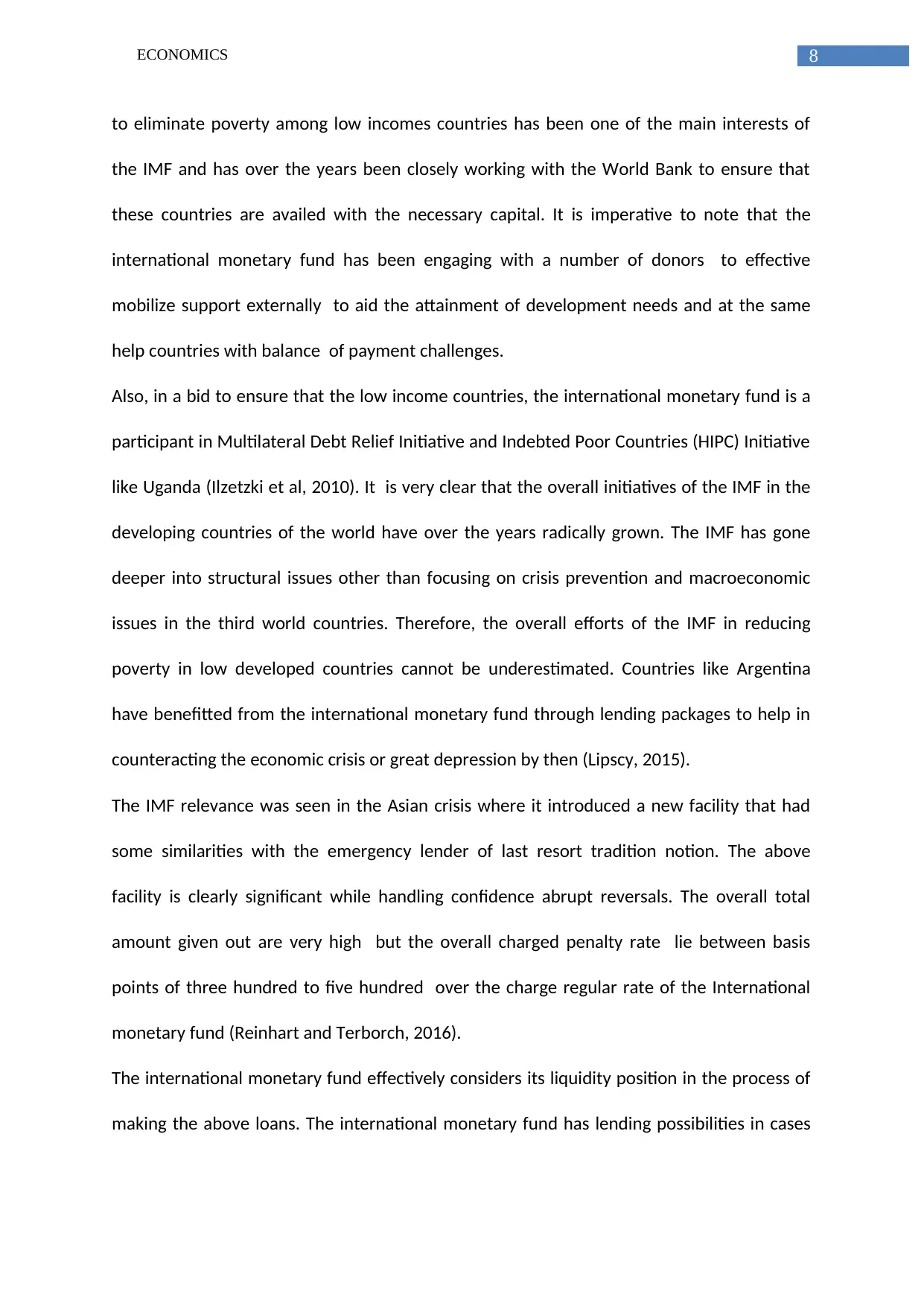
8ECONOMICS
to eliminate poverty among low incomes countries has been one of the main interests of
the IMF and has over the years been closely working with the World Bank to ensure that
these countries are availed with the necessary capital. It is imperative to note that the
international monetary fund has been engaging with a number of donors to effective
mobilize support externally to aid the attainment of development needs and at the same
help countries with balance of payment challenges.
Also, in a bid to ensure that the low income countries, the international monetary fund is a
participant in Multilateral Debt Relief Initiative and Indebted Poor Countries (HIPC) Initiative
like Uganda (Ilzetzki et al, 2010). It is very clear that the overall initiatives of the IMF in the
developing countries of the world have over the years radically grown. The IMF has gone
deeper into structural issues other than focusing on crisis prevention and macroeconomic
issues in the third world countries. Therefore, the overall efforts of the IMF in reducing
poverty in low developed countries cannot be underestimated. Countries like Argentina
have benefitted from the international monetary fund through lending packages to help in
counteracting the economic crisis or great depression by then (Lipscy, 2015).
The IMF relevance was seen in the Asian crisis where it introduced a new facility that had
some similarities with the emergency lender of last resort tradition notion. The above
facility is clearly significant while handling confidence abrupt reversals. The overall total
amount given out are very high but the overall charged penalty rate lie between basis
points of three hundred to five hundred over the charge regular rate of the International
monetary fund (Reinhart and Terborch, 2016).
The international monetary fund effectively considers its liquidity position in the process of
making the above loans. The international monetary fund has lending possibilities in cases
to eliminate poverty among low incomes countries has been one of the main interests of
the IMF and has over the years been closely working with the World Bank to ensure that
these countries are availed with the necessary capital. It is imperative to note that the
international monetary fund has been engaging with a number of donors to effective
mobilize support externally to aid the attainment of development needs and at the same
help countries with balance of payment challenges.
Also, in a bid to ensure that the low income countries, the international monetary fund is a
participant in Multilateral Debt Relief Initiative and Indebted Poor Countries (HIPC) Initiative
like Uganda (Ilzetzki et al, 2010). It is very clear that the overall initiatives of the IMF in the
developing countries of the world have over the years radically grown. The IMF has gone
deeper into structural issues other than focusing on crisis prevention and macroeconomic
issues in the third world countries. Therefore, the overall efforts of the IMF in reducing
poverty in low developed countries cannot be underestimated. Countries like Argentina
have benefitted from the international monetary fund through lending packages to help in
counteracting the economic crisis or great depression by then (Lipscy, 2015).
The IMF relevance was seen in the Asian crisis where it introduced a new facility that had
some similarities with the emergency lender of last resort tradition notion. The above
facility is clearly significant while handling confidence abrupt reversals. The overall total
amount given out are very high but the overall charged penalty rate lie between basis
points of three hundred to five hundred over the charge regular rate of the International
monetary fund (Reinhart and Terborch, 2016).
The international monetary fund effectively considers its liquidity position in the process of
making the above loans. The international monetary fund has lending possibilities in cases
⊘ This is a preview!⊘
Do you want full access?
Subscribe today to unlock all pages.

Trusted by 1+ million students worldwide
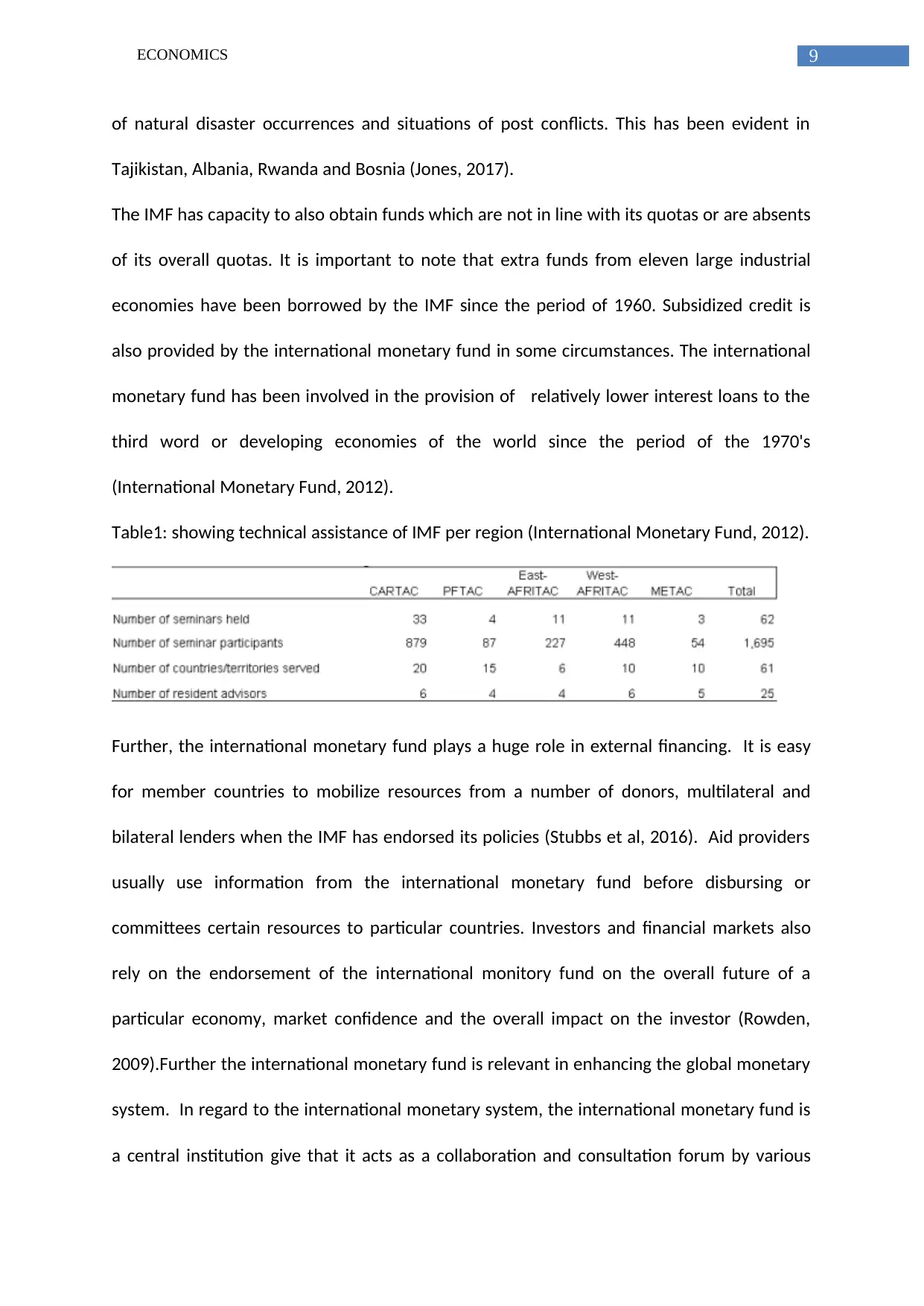
9ECONOMICS
of natural disaster occurrences and situations of post conflicts. This has been evident in
Tajikistan, Albania, Rwanda and Bosnia (Jones, 2017).
The IMF has capacity to also obtain funds which are not in line with its quotas or are absents
of its overall quotas. It is important to note that extra funds from eleven large industrial
economies have been borrowed by the IMF since the period of 1960. Subsidized credit is
also provided by the international monetary fund in some circumstances. The international
monetary fund has been involved in the provision of relatively lower interest loans to the
third word or developing economies of the world since the period of the 1970's
(International Monetary Fund, 2012).
Table1: showing technical assistance of IMF per region (International Monetary Fund, 2012).
Further, the international monetary fund plays a huge role in external financing. It is easy
for member countries to mobilize resources from a number of donors, multilateral and
bilateral lenders when the IMF has endorsed its policies (Stubbs et al, 2016). Aid providers
usually use information from the international monetary fund before disbursing or
committees certain resources to particular countries. Investors and financial markets also
rely on the endorsement of the international monitory fund on the overall future of a
particular economy, market confidence and the overall impact on the investor (Rowden,
2009).Further the international monetary fund is relevant in enhancing the global monetary
system. In regard to the international monetary system, the international monetary fund is
a central institution give that it acts as a collaboration and consultation forum by various
of natural disaster occurrences and situations of post conflicts. This has been evident in
Tajikistan, Albania, Rwanda and Bosnia (Jones, 2017).
The IMF has capacity to also obtain funds which are not in line with its quotas or are absents
of its overall quotas. It is important to note that extra funds from eleven large industrial
economies have been borrowed by the IMF since the period of 1960. Subsidized credit is
also provided by the international monetary fund in some circumstances. The international
monetary fund has been involved in the provision of relatively lower interest loans to the
third word or developing economies of the world since the period of the 1970's
(International Monetary Fund, 2012).
Table1: showing technical assistance of IMF per region (International Monetary Fund, 2012).
Further, the international monetary fund plays a huge role in external financing. It is easy
for member countries to mobilize resources from a number of donors, multilateral and
bilateral lenders when the IMF has endorsed its policies (Stubbs et al, 2016). Aid providers
usually use information from the international monetary fund before disbursing or
committees certain resources to particular countries. Investors and financial markets also
rely on the endorsement of the international monitory fund on the overall future of a
particular economy, market confidence and the overall impact on the investor (Rowden,
2009).Further the international monetary fund is relevant in enhancing the global monetary
system. In regard to the international monetary system, the international monetary fund is
a central institution give that it acts as a collaboration and consultation forum by various
Paraphrase This Document
Need a fresh take? Get an instant paraphrase of this document with our AI Paraphraser
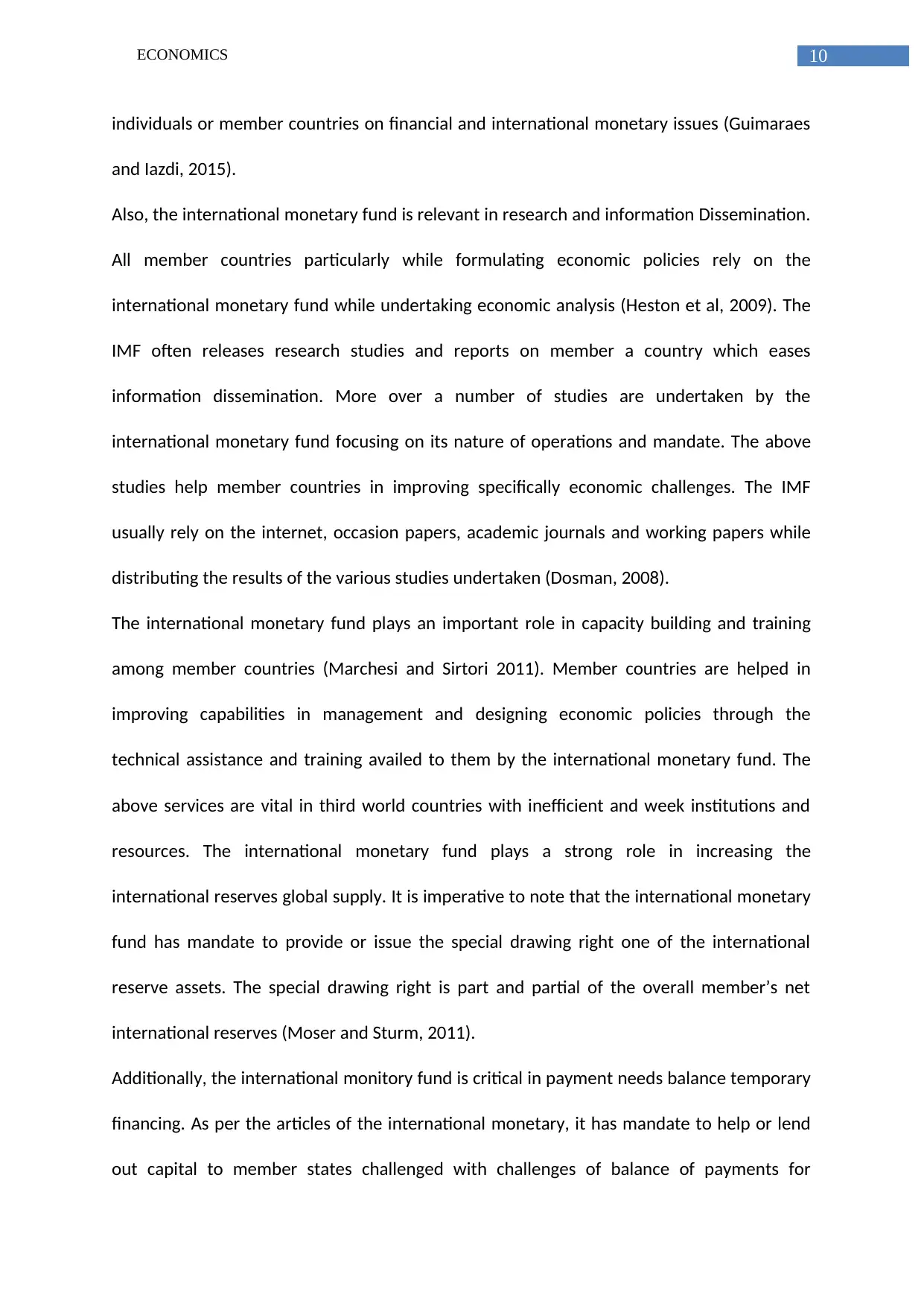
10ECONOMICS
individuals or member countries on financial and international monetary issues (Guimaraes
and Iazdi, 2015).
Also, the international monetary fund is relevant in research and information Dissemination.
All member countries particularly while formulating economic policies rely on the
international monetary fund while undertaking economic analysis (Heston et al, 2009). The
IMF often releases research studies and reports on member a country which eases
information dissemination. More over a number of studies are undertaken by the
international monetary fund focusing on its nature of operations and mandate. The above
studies help member countries in improving specifically economic challenges. The IMF
usually rely on the internet, occasion papers, academic journals and working papers while
distributing the results of the various studies undertaken (Dosman, 2008).
The international monetary fund plays an important role in capacity building and training
among member countries (Marchesi and Sirtori 2011). Member countries are helped in
improving capabilities in management and designing economic policies through the
technical assistance and training availed to them by the international monetary fund. The
above services are vital in third world countries with inefficient and week institutions and
resources. The international monetary fund plays a strong role in increasing the
international reserves global supply. It is imperative to note that the international monetary
fund has mandate to provide or issue the special drawing right one of the international
reserve assets. The special drawing right is part and partial of the overall member’s net
international reserves (Moser and Sturm, 2011).
Additionally, the international monitory fund is critical in payment needs balance temporary
financing. As per the articles of the international monetary, it has mandate to help or lend
out capital to member states challenged with challenges of balance of payments for
individuals or member countries on financial and international monetary issues (Guimaraes
and Iazdi, 2015).
Also, the international monetary fund is relevant in research and information Dissemination.
All member countries particularly while formulating economic policies rely on the
international monetary fund while undertaking economic analysis (Heston et al, 2009). The
IMF often releases research studies and reports on member a country which eases
information dissemination. More over a number of studies are undertaken by the
international monetary fund focusing on its nature of operations and mandate. The above
studies help member countries in improving specifically economic challenges. The IMF
usually rely on the internet, occasion papers, academic journals and working papers while
distributing the results of the various studies undertaken (Dosman, 2008).
The international monetary fund plays an important role in capacity building and training
among member countries (Marchesi and Sirtori 2011). Member countries are helped in
improving capabilities in management and designing economic policies through the
technical assistance and training availed to them by the international monetary fund. The
above services are vital in third world countries with inefficient and week institutions and
resources. The international monetary fund plays a strong role in increasing the
international reserves global supply. It is imperative to note that the international monetary
fund has mandate to provide or issue the special drawing right one of the international
reserve assets. The special drawing right is part and partial of the overall member’s net
international reserves (Moser and Sturm, 2011).
Additionally, the international monitory fund is critical in payment needs balance temporary
financing. As per the articles of the international monetary, it has mandate to help or lend
out capital to member states challenged with challenges of balance of payments for
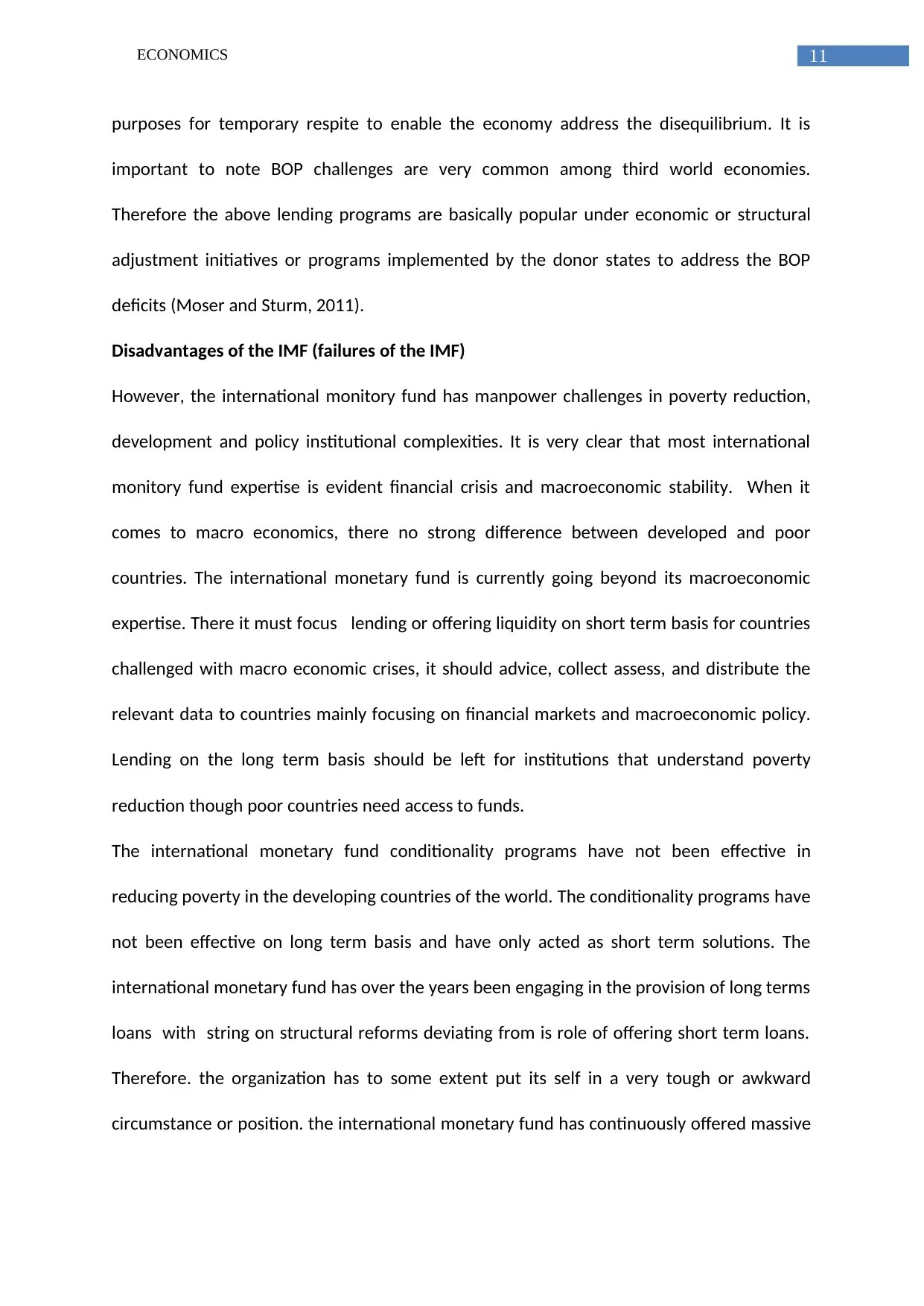
11ECONOMICS
purposes for temporary respite to enable the economy address the disequilibrium. It is
important to note BOP challenges are very common among third world economies.
Therefore the above lending programs are basically popular under economic or structural
adjustment initiatives or programs implemented by the donor states to address the BOP
deficits (Moser and Sturm, 2011).
Disadvantages of the IMF (failures of the IMF)
However, the international monitory fund has manpower challenges in poverty reduction,
development and policy institutional complexities. It is very clear that most international
monitory fund expertise is evident financial crisis and macroeconomic stability. When it
comes to macro economics, there no strong difference between developed and poor
countries. The international monetary fund is currently going beyond its macroeconomic
expertise. There it must focus lending or offering liquidity on short term basis for countries
challenged with macro economic crises, it should advice, collect assess, and distribute the
relevant data to countries mainly focusing on financial markets and macroeconomic policy.
Lending on the long term basis should be left for institutions that understand poverty
reduction though poor countries need access to funds.
The international monetary fund conditionality programs have not been effective in
reducing poverty in the developing countries of the world. The conditionality programs have
not been effective on long term basis and have only acted as short term solutions. The
international monetary fund has over the years been engaging in the provision of long terms
loans with string on structural reforms deviating from is role of offering short term loans.
Therefore. the organization has to some extent put its self in a very tough or awkward
circumstance or position. the international monetary fund has continuously offered massive
purposes for temporary respite to enable the economy address the disequilibrium. It is
important to note BOP challenges are very common among third world economies.
Therefore the above lending programs are basically popular under economic or structural
adjustment initiatives or programs implemented by the donor states to address the BOP
deficits (Moser and Sturm, 2011).
Disadvantages of the IMF (failures of the IMF)
However, the international monitory fund has manpower challenges in poverty reduction,
development and policy institutional complexities. It is very clear that most international
monitory fund expertise is evident financial crisis and macroeconomic stability. When it
comes to macro economics, there no strong difference between developed and poor
countries. The international monetary fund is currently going beyond its macroeconomic
expertise. There it must focus lending or offering liquidity on short term basis for countries
challenged with macro economic crises, it should advice, collect assess, and distribute the
relevant data to countries mainly focusing on financial markets and macroeconomic policy.
Lending on the long term basis should be left for institutions that understand poverty
reduction though poor countries need access to funds.
The international monetary fund conditionality programs have not been effective in
reducing poverty in the developing countries of the world. The conditionality programs have
not been effective on long term basis and have only acted as short term solutions. The
international monetary fund has over the years been engaging in the provision of long terms
loans with string on structural reforms deviating from is role of offering short term loans.
Therefore. the organization has to some extent put its self in a very tough or awkward
circumstance or position. the international monetary fund has continuously offered massive
⊘ This is a preview!⊘
Do you want full access?
Subscribe today to unlock all pages.

Trusted by 1+ million students worldwide
1 out of 21
Related Documents
Your All-in-One AI-Powered Toolkit for Academic Success.
+13062052269
info@desklib.com
Available 24*7 on WhatsApp / Email
![[object Object]](/_next/static/media/star-bottom.7253800d.svg)
Unlock your academic potential
Copyright © 2020–2025 A2Z Services. All Rights Reserved. Developed and managed by ZUCOL.





